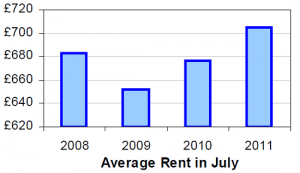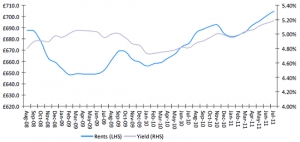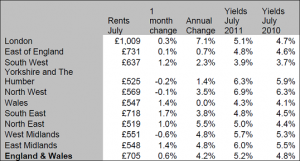Rents rose for the sixth month in a row in July, to a new record high, according to the latest Buy‐to‐Let Index from LSL Property Services plc, which owns the UK’s largest lettings agent network, including national chains Your Move and Reeds Rains.
 |
| [relatedPosts title=”Related Posts”] |
|
|
- Rents rise for sixth consecutive month, up by 0.6% to £705 pcm in July, with annual rent inflation at 4.2%
- Total annual returns fall to 1.2% as capital losses undermine strong yields
- Tenants improve finances in run up to summer holiday season as total amount of rent late or unpaid falls from 9.3% to 9%
In July, the average rent in England and Wales rose by 0.6% to £705 per month, surpassing the previous high of £701 in June. With annual inflation at 4.2%, the average rent is now £29 pcm higher than July 2010. The average yield reached 5.2% in July, up from 4.8% a year ago.
London saw by far the greatest annual rent increase in England and Wales. In July, rents hit a new high of £1,009 per month – an annual increase of 7.1%. The next biggest rises were in the North East where rents increased by 5.5%, and the East and West Midlands, where rents rose by 4.8%. In the last year, average rents have risen in all regions except Wales, where they now are at the same level as July 2010.
On a monthly basis, rents increased fastest in the South East, where they rose 1.7%. In Wales and the East Midlands, they increased by 1.4% compared to June. Rents declined in three regions – the West Midlands, where they fell by 0.6%, Yorkshire & the Humber and the North West, where rents fell by 0.2% and 0.1% respectively.
David Newnes, estate agency managing director of LSL Property Services, owners of Your Move and Reeds Rains comments:
“Rents are on an upward trajectory, and it is unlikely that tenants will gain respite any time soon. Demand from thousands of frustrated buyers each month is underpinning buoyant competition for rental homes, enabling landlords to increase prices. This is the peak summer season, with more renters on the move, the market will continue to heat up. Such strong demand and high rental incomes has forced lenders to take notice, and more are returning to the sector. As a result of the competition in the buy‐to‐let market, the range of affordable products is expanding – and lending to investors rose by 21% in the last quarter. Nevertheless, even with squeeze on landlord finance abating, the new supply will not be enough to meet demand from
tenants.“The increasing cost of rental accommodation – alongside the soaring cost of living – is eroding first‐time buyers’ ability to save deposits. But first‐time renters are also keenly feeling the pinch. As rents climbs, so does the size of the average deposit a new renter must find. Thousands of new buyers each year rely on the bank of Mum and Dad to help fund a deposit. However, now it is becoming increasingly commonplace for renters to get parental help to fund their first deposit on a rental home, with the typical one month deposit on a property in London more than £1,000.”
The total annual return on a rental property fell to 1.2% in July as annual declines in rental property prices took their toll. The total annual return is the equivalent of £2,060 ‐ £7,522 in rent, with a capital loss of £5,462. If property values continue on their current trend, a property investor could expect to make a total annual return of 2.5% over the next 12 months – equivalent to £4,093 per property.[1]
David Newnes continues:
“Falling property prices are holding back total annual returns and will continue to do so over the short‐term. But the vast majority of prospective investors look at longer‐term fundamentals such as tenant demand and yields – and these are looking increasingly attractive. ”
Tenant arrears decreased for a third consecutive month, with 9% of all UK rent unpaid or late by the end of July – down from the 9.3% of rent unpaid or late in June. Unpaid rent totalled £251m across the UK in July, down 2.4% from the £257m unpaid in the previous month.
Newnes concludes:
“Tenant finances have performed remarkably well in recent months and arrears are down as landlords show less forbearance with tenants experiencing payment problems. As a result, landlords’ mortgage arrears have dropped – and are actually lower than arrears in the owner occupied sector for the first time in three years. But with question marks over the economy, and public sector job losses still to come, tenant finances will be placed under increasing stress. Rents won’t drop anytime soon, and we anticipate the number of tenants facing payment difficulties will climb.”
Further Information
[1] Assuming house prices change at the average rate of the last three months and they achieve the average yield of 5.2%.
Methodology:
The buy‐to‐let index is based on analysis of over 18,000 properties across the UK each month. Rental values refer to the actual values achieved for each property when let during the month. Yield figures are unadjusted, and do not take account of void periods or arrears. Annual returns are based on annual rental property price inflation and void‐adjusted yield at the point of purchase.








